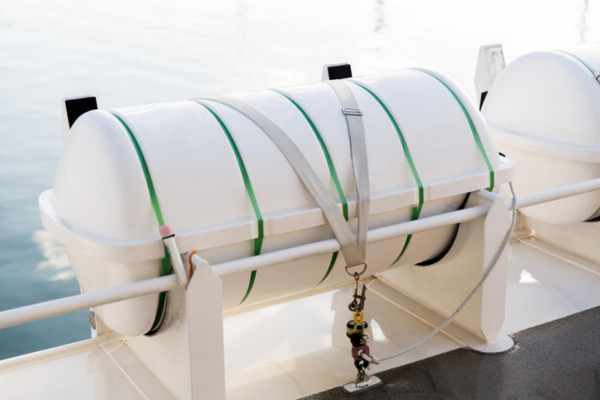When you step on board a ship, whether it’s a massive cargo vessel or a small fishing boat, your safety is paramount. This is where life raft containers come into play – these indispensable pieces of safety equipment serve as your last defense when emergencies arise on the open sea. But what exactly goes into making these life-saving containers? Let’s find out.

Understanding Life Raft Containers
Importance of Life Raft Containers
Life raft containers are essentially survival chambers that can house stranded crew members until rescue arrives. Given their vital role, the quality and effectiveness of these containers is of the utmost importance.
Construction and Materials
The durability and performance of life raft containers lie largely in their construction and the materials used. These containers have to be sturdy yet light, resistant to punctures and sea water, and capable of withstanding harsh marine environments.
Commonly Used Materials
Understanding the materials used in these containers can give us a better idea of their performance and functionality.
Fiberglass
Fiberglass, known for its strength and resistance to seawater, is a popular choice. It’s tough, resilient and can easily withstand the marine environment.
PVC (Polyvinyl Chloride)
PVC is another commonly used material in life raft containers. It’s lightweight, flexible, and can be easily inflated and deflated.
Hypalon
Hypalon is noted for its exceptional durability. It’s resistant to UV rays, oil, chemicals, and extreme temperatures, making it a go-to choice for high-quality life raft containers.
Pros and Cons of Materials
Each of these materials brings its own set of advantages and potential drawbacks.
Fiberglass
While fiberglass offers excellent puncture resistance, ideal for offshore conditions, it’s on the heavier side compared to the other materials.
PVC
PVC’s main advantages are its light weight and ease of handling. However, its durability may not match up to that of the other options.
Hypalon
Hypalon is undoubtedly resistant to various elements, but its superior qualities come with a higher price tag.
Impact of Material Choice on Performance
The choice of material can significantly affect the performance of the life raft container.
Buoyancy
The buoyancy properties of the material can determine how well the container will float when inflated with air or CO2 during an emergency.
Durability
A robust material ensures that the container can withstand rough sea conditions, potential impacts, and UV radiation.
Inflation System Compatibility
Different materials may require specific inflation systems to ensure proper deployment of the life raft.
Industry Standards and Regulations
Compliance with stringent industry standards and regulations, such as the SOLAS (Safety of Life at Sea) Convention, is essential to guarantee the reliability of these life-saving devices.
SOLAS
The SOLAS convention sets international requirements for life-saving appliances, including life rafts. These regulations cover aspects such as capacity, equipment, launching systems, maintenance, and inspections.
Best Practices in Container Selection
When choosing a life raft container, there are several factors to consider.
SOLAS Compliance
Ensure the container meets SOLAS regulations and has appropriate certification from recognized authorities like the United States Coast Guard.
Capacity Assessment
Assess the capacity of the life raft based on the number of persons it can accommodate.
Safety Features
Verify the inclusion of safety features like hydrostatic release units, reflective tape for visibility, survival equipment (flares, flashlights), first aid kits, food rations, fresh water provisions (at least 1.5 liters per person), and signaling devices like SARTs (Search and Rescue Transponders).
Case Studies and Real-Life Examples
Real-life examples underscore the importance of having reliable life raft containers on board. Consider the case of a large ship that encountered a severe storm and capsized. Thanks to robust life rafts, the crew members could evacuate safely until rescue arrived.
Expert Recommendations
Experts recommend assessing the vessel’s deck space for stowing larger containers or multiple smaller ones and prioritizing materials that offer the best balance between durability and weight.
Conclusion
In conclusion, life raft containers play an instrumental role in marine safety. By understanding the materials used in their construction, their pros and cons, and the impact of these factors on performance, you can make an informed decision when selecting the right life raft container.
FAQs
- What are the most commonly used materials in life raft containers?
- Fiberglass, PVC, and Hypalon are commonly used in the construction of life raft containers.
- What are the pros and cons of using PVC in life raft containers?
- PVC is lightweight and easy to handle, but it may not be as durable as other options like Fiberglass or Hypalon.
- What is SOLAS?
- SOLAS stands for Safety of Life at Sea. It is an international maritime safety treaty that sets minimum safety standards in the construction, equipment, and operation of merchant ships.
- What safety features should be included in a life raft container?
- Safety features should include hydrostatic release units, reflective tape for visibility, survival equipment, first aid kits, food rations, fresh water provisions, and signaling devices.
- What factors should I consider when choosing a life raft container?
- Factors to consider include SOLAS compliance, capacity assessment, the inclusion of safety features, and the availability of deck space on the vessel.
